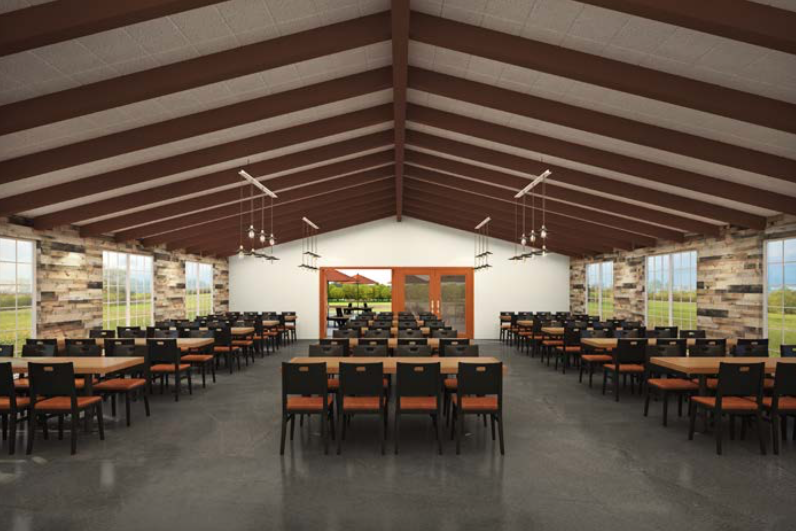A shuttered juvenile detention camp in the far reaches of Los Angeles County’s Antelope Valley will become a live-in job training site for young adults who’ve been homeless, incarcerated or raised by the foster care system, under a $35 million plan approved last week by county supervisors.
The first-of-its kind plan, long envisioned by local leaders, would serve these “opportunity youth” on the refurbished campus of the largest probation camp in the country, stretching nearly 220,000 square feet across 65 acres.
Unlike those sentenced to the Challenger Memorial Youth Center that has long occupied the site, the new project would be voluntary, serving needy young people who choose to sign themselves up for housing and supportive services, rather than being directed by a court, social worker or probation officer to do so. After fits and starts over years, the current version of the proposal calls for a program serving young women ages 18 to 30 and young men ages 18 to 25, as well as the children of those who are parents. It is set for a late 2023 or early 2024 launch.
The young adults would live at the Lancaster campus for six to 18 months, receiving a range of educational opportunities from high school through four-year college, as well as vocational training and career counseling. The program would also provide comprehensive mental health services, life-skills instruction and child care, with the goal of landing a living-wage job and secure housing.

“Faced with inter-generational poverty, traumatic life experiences, and lack of opportunity for meaningful education or employment, these young men and women have never been offered the real opportunity for success that this initiative will provide,” a description of the project reads.
The effort to create a voluntary vocational education program with a housing component has been a goal of Los Angeles County supervisors for the past four years. But there have been repeated disruptions and delays – from ill-fated contracts to wildfires and, most recently, a historic global pandemic.
In a lofty description of the project last year, two months before the coronavirus emerged, a report to county supervisors anticipated the revised camp program would “achieve transformative social change.”
“By turning away from incarcerating young people and moving toward educating and supporting them, by transforming a punitive detention facility into a place of home, opportunity and hope, we are investing in the future of our youth and our country,” the report stated. “Our aim is nothing less than to provide a replicable model that can change the life trajectory of a generation.”
Supporters say the project is consistent with a countywide effort to expand human services and reduce reliance on incarceration. In recent years, Los Angeles County has halted plans for a new adult jail and proposed dozens of recommendations for interventions in lieu of locking people up. Last November, voters approved Measure J, which will divert millions of dollars from law enforcement to youth development, housing and mental health programs. The county is also working to revamp its juvenile justice system by offering greater access to therapeutic programs and moving children out of detention settings.

Deborah Kanter, a county consultant who has been working on the Challenger project for the past year and a half, said it is aimed at correcting historic injustice. From 1980 to 2010, California opened 23 prisons but just one University of California college campus, a time when millions of dollars went into juvenile detention camps like the massive 660-bed Challenger.
In 2017, Los Angeles County began exploring a way to convert Camp David Gonzales, another detention camp 35 miles north of downtown Los Angeles, into a version of the residential vocational program now before the supervisors. But that project got derailed three years later when the county terminated a $3.5 million contract with New Earth, the community-based organization selected to lead the effort, with officials citing the group’s weak fiscal controls.
The current plan to operate a vocational ed program on the vast grounds of the Challenger site was first approved by the Board of Supervisors in October 2018.
Located on property in Lancaster that borders a state prison, the Challenger camp had been scheduled to close amid a sharp decline in juvenile arrests and subsequent drop in the number of incarcerated youth at the state and local level. Over the past roughly 10 years, the number of juvenile offenders detained in Los Angeles County camps has plunged from 1,200 to just 150 today. Meanwhile, the state is months away from shuttering its youth prisons that once held 10,000 teens and young adults, and now just 750.
The early-stage plan to overhaul the Challenger camp received widespread support at the October 2018 county supervisors meeting – with proponents ranging from representatives of Antelope Valley College to the $30 billion multinational aerospace and weapons manufacturer Northrop Grumman Corp. and the Los Angeles County Building and Construction Trades Council. Supporters spoke in favor of creating an alternative to incarceration, as well as a pipeline to the workforce in the Antelope Valley, a remote section of the county with one of the highest concentrations of youth on probation and in foster care.
“These are not just numbers,” Supervisor Kathryn Barger said at the meeting, remarking on the numbers of disengaged youth in her district. “They are young people who are trying to find their way in the world – many of them with no guidance or support.”

Yet one month after she spoke, the devastating Woolsey Fire tore through Los Angeles and Ventura countries, damaging another camp run by the Probation Department, Malibu’s Camp Kilpatrick. As a result, the youth who had been detained there were moved to the Challenger site, an arrangement that persisted through last July and delayed plans to transform its campus into a non-detention site.
Then the pandemic struck, delaying plans further – until last week when the project got revived yet again by Supervisor Barger.
Samantha Harvell, an Urban Institute researcher who has tracked how local jurisdictions have dealt with some of the hundreds of shuttered juvenile detention centers nationwide, called the Challenger project “a unique opportunity.” She said many counties have been eager to escape the maintenance costs for these facilities, often transferring the land to another party for a cheap price – sometimes just $1.
Harvell said these vacant detention facilities have seen second lives as affordable housing projects, shopping centers, teen centers and social services hubs. She described Los Angeles County’s plan as rare among those she’s studied.
Under the current plan, Los Angeles County will pay for all program and operating expenses; funds to outfit and renovate the current campus are estimated to cost $35 million. Of that cost, $10 million has already been identified, including $5 million in seed funding from the 2019-2020 state budget. The project has also received financial support from the Reissa Foundation* and the Specialty Family Foundation. In addition to seeking additional funding streams to meet the $35 million goal, the chief executive’s office will now work to identify a nonprofit organization to lead the Challenger initiative. A report that includes a timeline, a proposed budget and a review of available funding streams for construction costs is due back in 45 days.
County consultant Kanter said there are numerous employers in the Antelope Valley who are looking for skilled employees and have expressed interest in the job-feeder program, including the aerospace, carpentry and construction fields.
“The scope of this project is intended to address severe inequities in the Antelope Valley,” Kanter said, “and to serve a population that has historically been underserved and that is so deserving.”
*The Reissa Foundation provide funding to The Imprint’s parent organization, Fostering Media Connections. It had no involvement with this article, per our editorial independence policy.





